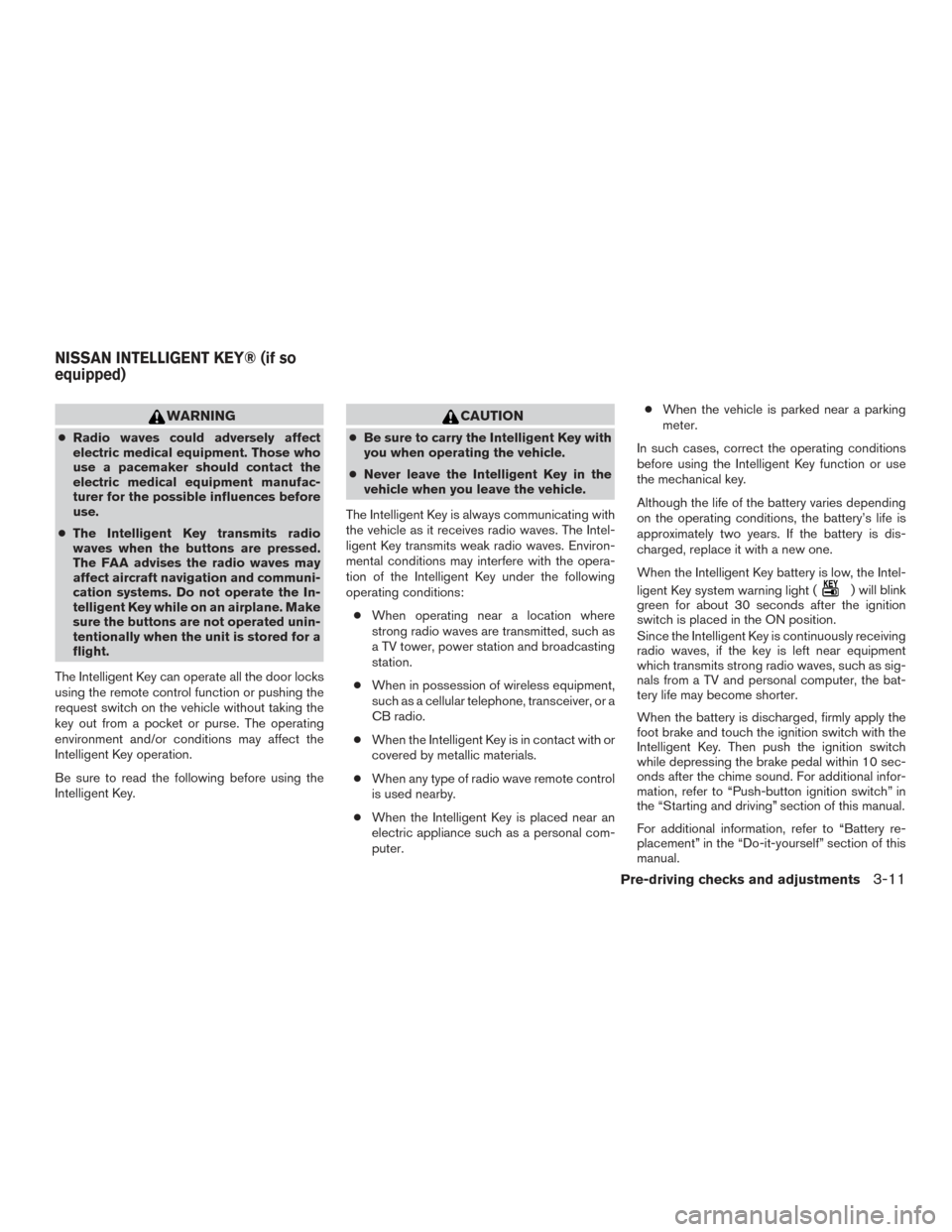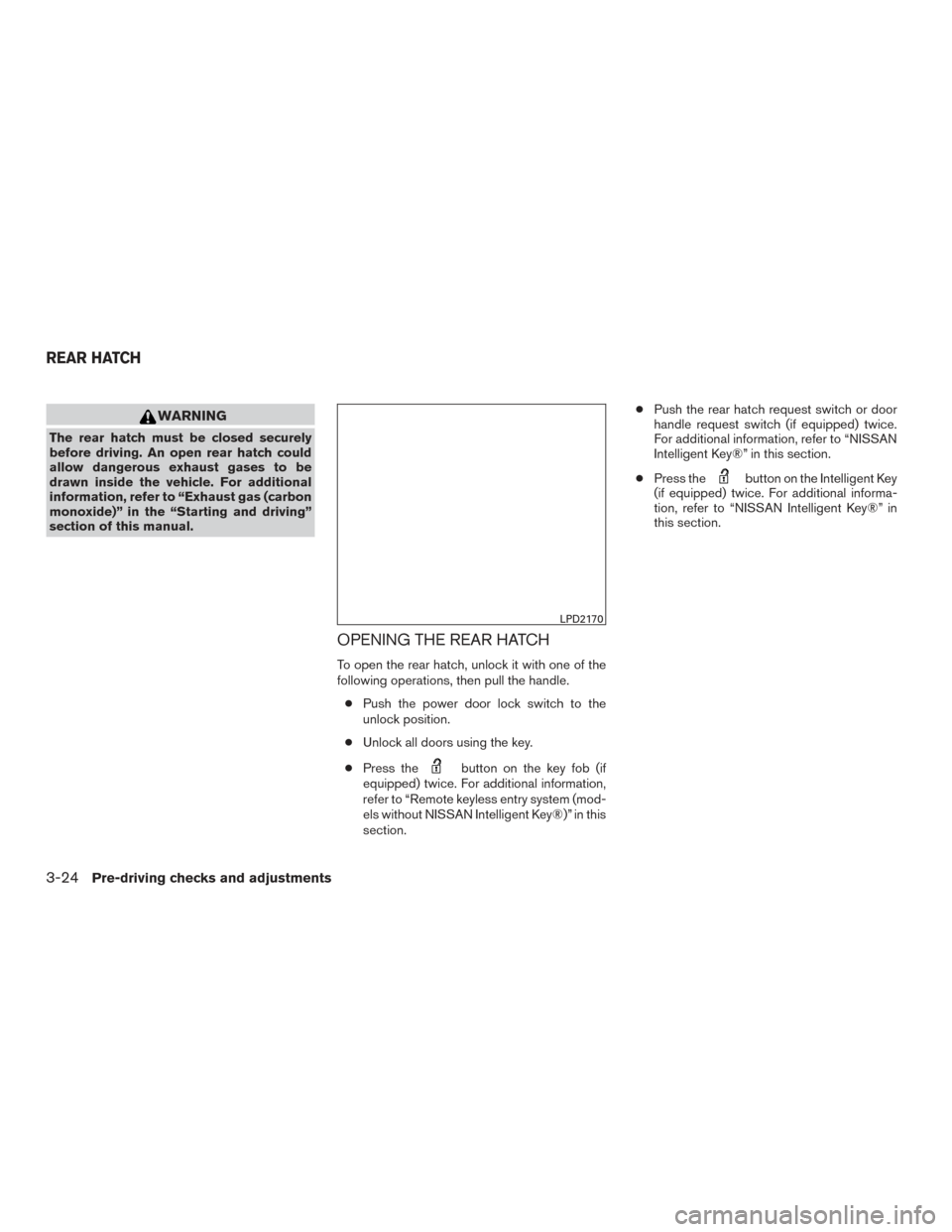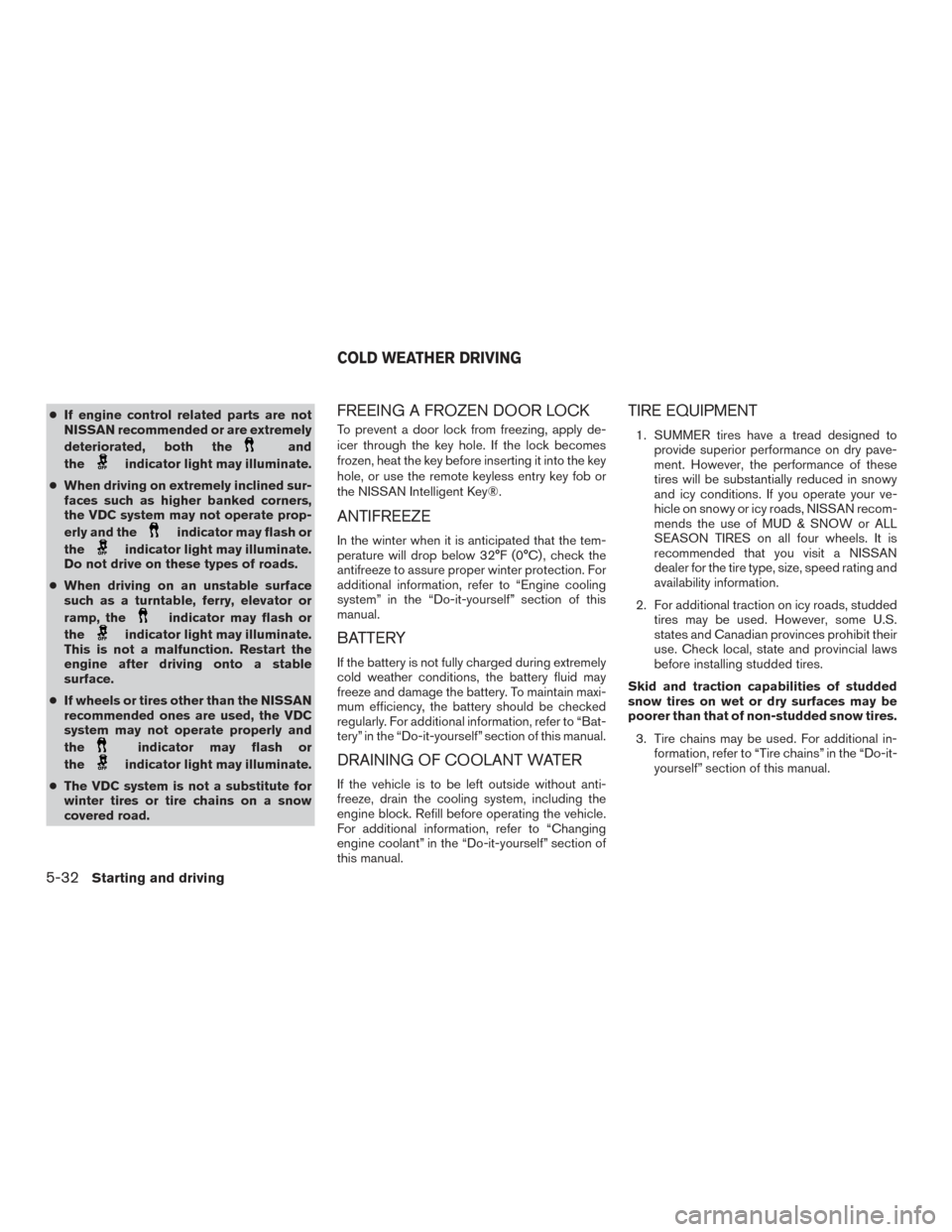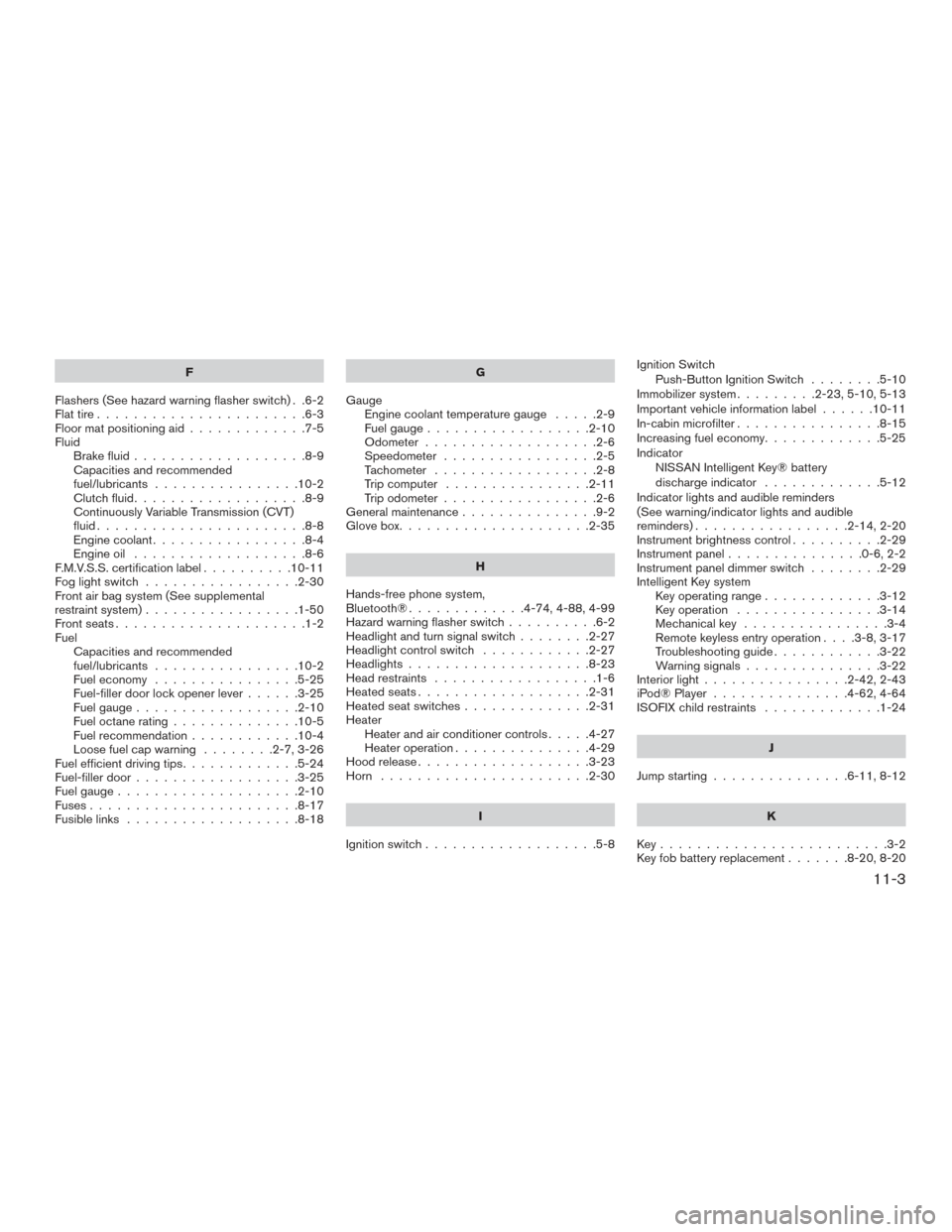2017 NISSAN VERSA NOTE remote start
[x] Cancel search: remote startPage 134 of 414

WARNING
●Radio waves could adversely affect
electric medical equipment. Those who
use a pacemaker should contact the
electric medical equipment manufac-
turer for the possible influences before
use.
● The Intelligent Key transmits radio
waves when the buttons are pressed.
The FAA advises the radio waves may
affect aircraft navigation and communi-
cation systems. Do not operate the In-
telligent Key while on an airplane. Make
sure the buttons are not operated unin-
tentionally when the unit is stored for a
flight.
The Intelligent Key can operate all the door locks
using the remote control function or pushing the
request switch on the vehicle without taking the
key out from a pocket or purse. The operating
environment and/or conditions may affect the
Intelligent Key operation.
Be sure to read the following before using the
Intelligent Key.
CAUTION
● Be sure to carry the Intelligent Key with
you when operating the vehicle.
● Never leave the Intelligent Key in the
vehicle when you leave the vehicle.
The Intelligent Key is always communicating with
the vehicle as it receives radio waves. The Intel-
ligent Key transmits weak radio waves. Environ-
mental conditions may interfere with the opera-
tion of the Intelligent Key under the following
operating conditions: ● When operating near a location where
strong radio waves are transmitted, such as
a TV tower, power station and broadcasting
station.
● When in possession of wireless equipment,
such as a cellular telephone, transceiver, or a
CB radio.
● When the Intelligent Key is in contact with or
covered by metallic materials.
● When any type of radio wave remote control
is used nearby.
● When the Intelligent Key is placed near an
electric appliance such as a personal com-
puter. ●
When the vehicle is parked near a parking
meter.
In such cases, correct the operating conditions
before using the Intelligent Key function or use
the mechanical key.
Although the life of the battery varies depending
on the operating conditions, the battery’s life is
approximately two years. If the battery is dis-
charged, replace it with a new one.
When the Intelligent Key battery is low, the Intel-
ligent Key system warning light (
) will blink
green for about 30 seconds after the ignition
switch is placed in the ON position.
Since the Intelligent Key is continuously receiving
radio waves, if the key is left near equipment
which transmits strong radio waves, such as sig-
nals from a TV and personal computer, the bat-
tery life may become shorter.
When the battery is discharged, firmly apply the
foot brake and touch the ignition switch with the
Intelligent Key. Then push the ignition switch
while depressing the brake pedal within 10 sec-
onds after the chime sound. For additional infor-
mation, refer to “Push-button ignition switch” in
the “Starting and driving” section of this manual.
For additional information, refer to “Battery re-
placement” in the “Do-it-yourself” section of this
manual.
NISSAN INTELLIGENT KEY® (if so
equipped)
Pre-driving checks and adjustments3-11
Page 147 of 414

WARNING
The rear hatch must be closed securely
before driving. An open rear hatch could
allow dangerous exhaust gases to be
drawn inside the vehicle. For additional
information, refer to “Exhaust gas (carbon
monoxide)” in the “Starting and driving”
section of this manual.
OPENING THE REAR HATCH
To open the rear hatch, unlock it with one of the
following operations, then pull the handle.● Push the power door lock switch to the
unlock position.
● Unlock all doors using the key.
● Press the
button on the key fob (if
equipped) twice. For additional information,
refer to “Remote keyless entry system (mod-
els without NISSAN Intelligent Key®)” in this
section. ●
Push the rear hatch request switch or door
handle request switch (if equipped) twice.
For additional information, refer to “NISSAN
Intelligent Key®” in this section.
● Press the
button on the Intelligent Key
(if equipped) twice. For additional informa-
tion, refer to “NISSAN Intelligent Key®” in
this section.
LPD2170
REAR HATCH
3-24Pre-driving checks and adjustments
Page 299 of 414

●If engine control related parts are not
NISSAN recommended or are extremely
deteriorated, both the
and
the
indicator light may illuminate.
● When driving on extremely inclined sur-
faces such as higher banked corners,
the VDC system may not operate prop-
erly and the
indicator may flash or
the
indicator light may illuminate.
Do not drive on these types of roads.
● When driving on an unstable surface
such as a turntable, ferry, elevator or
ramp, the
indicator may flash or
the
indicator light may illuminate.
This is not a malfunction. Restart the
engine after driving onto a stable
surface.
● If wheels or tires other than the NISSAN
recommended ones are used, the VDC
system may not operate properly and
the
indicator may flash or
the
indicator light may illuminate.
● The VDC system is not a substitute for
winter tires or tire chains on a snow
covered road.
FREEING A FROZEN DOOR LOCK
To prevent a door lock from freezing, apply de-
icer through the key hole. If the lock becomes
frozen, heat the key before inserting it into the key
hole, or use the remote keyless entry key fob or
the NISSAN Intelligent Key®.
ANTIFREEZE
In the winter when it is anticipated that the tem-
perature will drop below 32°F (0°C) , check the
antifreeze to assure proper winter protection. For
additional information, refer to “Engine cooling
system” in the “Do-it-yourself” section of this
manual.
BATTERY
If the battery is not fully charged during extremely
cold weather conditions, the battery fluid may
freeze and damage the battery. To maintain maxi-
mum efficiency, the battery should be checked
regularly. For additional information, refer to “Bat-
tery” in the “Do-it-yourself” section of this manual.
DRAINING OF COOLANT WATER
If the vehicle is to be left outside without anti-
freeze, drain the cooling system, including the
engine block. Refill before operating the vehicle.
For additional information, refer to “Changing
engine coolant” in the “Do-it-yourself” section of
this manual.
TIRE EQUIPMENT
1. SUMMER tires have a tread designed to
provide superior performance on dry pave-
ment. However, the performance of these
tires will be substantially reduced in snowy
and icy conditions. If you operate your ve-
hicle on snowy or icy roads, NISSAN recom-
mends the use of MUD & SNOW or ALL
SEASON TIRES on all four wheels. It is
recommended that you visit a NISSAN
dealer for the tire type, size, speed rating and
availability information.
2. For additional traction on icy roads, studded tires may be used. However, some U.S.
states and Canadian provinces prohibit their
use. Check local, state and provincial laws
before installing studded tires.
Skid and traction capabilities of studded
snow tires on wet or dry surfaces may be
poorer than that of non-studded snow tires. 3. Tire chains may be used. For additional in- formation, refer to “Tire chains” in the “Do-it-
yourself” section of this manual.
COLD WEATHER DRIVING
5-32Starting and driving
Page 408 of 414

F
Flashers (See hazard warning flasher switch) . .6-2
Flat tire .......................6-3
Floor mat positioning aid .............7-5
Fluid Brake fluid ...................8-9
Capacities and recommended
fuel/lubricants ................10-2
Clutchfluid...................8-9
Continuously Variable Transmission (CVT)
fluid.......................8-8
Engine coolant .................8-4
Engine oil ...................8-6
F.M.V.S.S. certification label ..........10-11
Foglightswitch .................2-30
Front air bag system (See supplemental
restraint system) .................1-50
Frontseats.....................1-2
Fuel Capacities and recommended
fuel/lubricants ................10-2
Fuel economy ................5-25
Fuel-filler door lock opener lever ......3-25
Fuel gauge ..................2-10
Fuel octane rating ..............10-5
Fuel recommendation ............10-4
Loose fuel cap warning ........2-7,3-26
Fuel efficient driving tips .............5-24
Fuel-filler door ..................3-25
Fuel gauge ....................2-10
Fuses.......................8-17
Fusible links ...................8-18 G
Gauge Engine coolant temperature gauge .....2-9
Fuel gauge ..................2-10
Odometer ...................2-6
Speedometer .................2-5
Tachometer ..................2-8
Trip computer ................2-11
Trip odometer .................2-6
General maintenance ...............9-2
Glovebox.....................2-35
H
Hands-free phone system,
Bluetooth®.............4-74,4-88,4-99
Hazard warning flasher switch ..........6-2
Headlight and turn signal switch ........2-27
Headlight control switch ............2-27
Headlights ....................8-23
Head restraints ..................1-6
Heated seats ...................2-31
Heated seat switches ..............2-31
Heater Heater and air conditioner controls .....4-27
Heater operation ...............4-29
Hood release ...................3-23
Horn .......................2-30
I
Ignition switch ...................5-8 Ignition Switch
Push-Button Ignition Switch ........5-10
Immobilizer system .........2-23,5-10,5-13
Important vehicle information label ......10-11
In-cabin microfilter ................8-15
Increasing fuel economy .............5-25
Indicator NISSAN Intelligent Key® battery
discharge indicator .............
5
-12
Indicator lights and audible reminders
(See warning/indicator lights and audible
reminders).................2-14,2-20
Instrument brightness control ..........2-29
Instrumentpanel...............0-6,2-2
Instrument panel dimmer switch ........2-29
Intelligent Key system Key operating range .............3-12
Key operation ................3-14
Mechanical key ................3-4
Remote keyless entry operation ....3-8,3-17
Troubleshooting guide ............3-22
Warning signals ...............3-22
Interior light ................2-42,2-43
iPod®Player ............... 4-62, 4-64
ISOFIX child restraints .............1-24
J
Jump starting ...............6-11,8-12
K
Key.........................3-2
Key fob battery replacement .......8-20,8-20
11-3